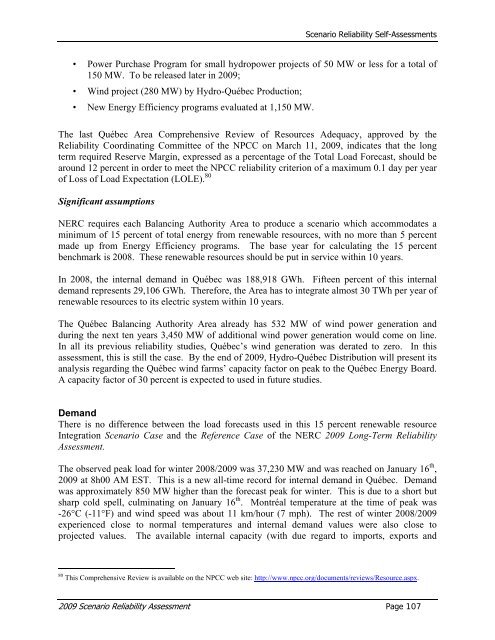2009 Scenario Reliability Assessment - NERC
2009 Scenario Reliability Assessment - NERC
2009 Scenario Reliability Assessment - NERC
- No tags were found...
Create successful ePaper yourself
Turn your PDF publications into a flip-book with our unique Google optimized e-Paper software.
<strong>Scenario</strong> <strong>Reliability</strong> Self-<strong>Assessment</strong>s• Power Purchase Program for small hydropower projects of 50 MW or less for a total of150 MW. To be released later in <strong>2009</strong>;• Wind project (280 MW) by Hydro-Québec Production;• New Energy Efficiency programs evaluated at 1,150 MW.The last Québec Area Comprehensive Review of Resources Adequacy, approved by the<strong>Reliability</strong> Coordinating Committee of the NPCC on March 11, <strong>2009</strong>, indicates that the longterm required Reserve Margin, expressed as a percentage of the Total Load Forecast, should bearound 12 percent in order to meet the NPCC reliability criterion of a maximum 0.1 day per yearof Loss of Load Expectation (LOLE). 80Significant assumptions<strong>NERC</strong> requires each Balancing Authority Area to produce a scenario which accommodates aminimum of 15 percent of total energy from renewable resources, with no more than 5 percentmade up from Energy Efficiency programs. The base year for calculating the 15 percentbenchmark is 2008. These renewable resources should be put in service within 10 years.In 2008, the internal demand in Québec was 188,918 GWh. Fifteen percent of this internaldemand represents 29,106 GWh. Therefore, the Area has to integrate almost 30 TWh per year ofrenewable resources to its electric system within 10 years.The Québec Balancing Authority Area already has 532 MW of wind power generation andduring the next ten years 3,450 MW of additional wind power generation would come on line.In all its previous reliability studies, Québec’s wind generation was derated to zero. In thisassessment, this is still the case. By the end of <strong>2009</strong>, Hydro-Québec Distribution will present itsanalysis regarding the Québec wind farms’ capacity factor on peak to the Québec Energy Board.A capacity factor of 30 percent is expected to used in future studies.DemandThere is no difference between the load forecasts used in this 15 percent renewable resourceIntegration <strong>Scenario</strong> Case and the Reference Case of the <strong>NERC</strong> <strong>2009</strong> Long-Term <strong>Reliability</strong><strong>Assessment</strong>.The observed peak load for winter 2008/<strong>2009</strong> was 37,230 MW and was reached on January 16 th ,<strong>2009</strong> at 8h00 AM EST. This is a new all-time record for internal demand in Québec. Demandwas approximately 850 MW higher than the forecast peak for winter. This is due to a short butsharp cold spell, culminating on January 16 th . Montréal temperature at the time of peak was-26°C (-11°F) and wind speed was about 11 km/hour (7 mph). The rest of winter 2008/<strong>2009</strong>experienced close to normal temperatures and internal demand values were also close toprojected values. The available internal capacity (with due regard to imports, exports and80 This Comprehensive Review is available on the NPCC web site: http://www.npcc.org/documents/reviews/Resource.aspx.<strong>2009</strong> <strong>Scenario</strong> <strong>Reliability</strong> <strong>Assessment</strong> Page 107
















